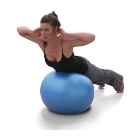Contraindicated Exercises Revisited
by Karen A. Kemper, MSPH, PhD, and Meghan Ferguson (Fitness Professional)
 Contraindicated Exercises Revisited -
Contraindicated Exercises Revisited -
By Karen A. Kemper, MSPH, PhD, and Meghan Ferguson
You have undoubtedly heard warnings about the use of exercises referred to as �contraindicated.� Exercises such as the deep squat, unsupported forward flexion, the plow, the hurdler�s stretch, the back bend, and both the full and straight-leg sit-up have typically been considered unsafe for the general population. You have probably been encouraged to avoid incorporating them into your programs. Yet you may have noticed that many of these same movements are commonly used in yoga and Pilates programs, seemingly without major concerns about safety.
How can you tell if a contraindicated exercise is really safe for a client? Consider the following 9 factors before implementing an exercise in your program, note Karen A. Kemper, MSPH, PhD, an associate professor in the department of public health sciences at Clemson University, and Meghan Ferguson, a senior honor student at Clemson University, who recently graduated with a bachelor�s degree in public health sciences and is planning to attend physical therapy school.
1. Nature of the Tissue. The nature of the tissue determines its ability to withstand stresses and loads without injury. Influential factors include adaptability, strength, endurance, elasticity, hydration, shrinkage, viscosity and motor control.
2. Injury History. Tissues that have been previously injured are more likely to be injured again, since they may be weakened and less able to withstand load challenges.
3. Time of Day. Intervertebral disks are more hydrated in the first hours of the morning. This hydration causes increased disk pressure and stiffness in the spine and decreases range of motion (ROM). Therefore, spinal flexion exercises should be avoided during the first hours of waking.
4. Fatigue. As tissues fatigue during exercise, their tolerance lowers and the margin of safety decreases. Once the supportive structures fatigue, ROM increases, and injuries occur more easily at the end ROM.
5. Age. Structural changes that occur with age may increase the risk of injury. Elasticity decreases, edema increases, and muscles begin to atrophy. Movement accuracy, speed, ROM, endurance, coordination, stability and strength may decrease, and the body is less able to tolerate compressive loads.
6. Gender. On average, women have a greater Q-angle than men. (The Q-angle describes the position of the patella relative to the tibia and the anterior superior spine of the ilium). This increased angle is thought to put more stress on the knee during squats. Men can tolerate greater compressive loads on the spine than women.
7. Motor Skill Ability. Muscles have the ability to �learn� patterns of movement. Improper techniques used in the initial stages of an exercise will train the muscles to contract inappropriately.
8. Flexibility. Increased flexibility of the hips and knees can reduce the risk of injury to the low back. However, excessive flexibility of the spine can decrease the erector spinae�s ability to prevent full forward flexion. Movement at the end ROM should be avoided during spinal flexion and rotation.
9. Loads on Tissue. Frequent or sustained loads and rapid or ballistic movements can decrease the load that can be tolerated by a given tissue.
|
|
|









 Contraindicated Exercises Revisited -
Contraindicated Exercises Revisited -